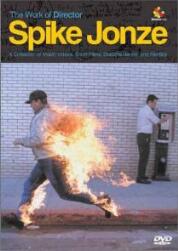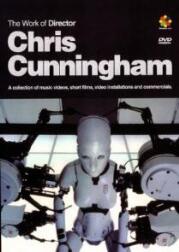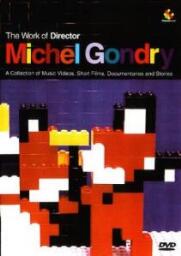The Directors Label DVD Series: The Madcap Creativity of Spike Jonze, Chris Cunningham and Michel Gondry
by dave heaton
Though film critics often throw the words "former music video director" at first-time film directors as an insult, it's an art form that's filled with creativity. The best videos have oddball flights of fancy, inventive concepts, and images that taunt you with their otherworldliness…and there's no reason such a commercial format, essentially an ad for music, needs to be even interesting. What's happened is that artists with the wherewithal to push the boundaries of the form have made the music video something that can achieve greatness, a form that with its brevity and freedom from narrative has the capacity to be even more out-there than feature films tend to be.
The Directors Label DVD series was started by three music video directors-Spike Jonze, Chris Cunningham, and Michel Gondry-to showcase their own music videos and those of their contemporaries. The first three DVDs in the series, each labeled "The Work of Director…," showcase their own work, but more DVDs are promised for next year. The fact that the three have each created some of the wildest and most interesting music videos makes them the right people to be behind such a project, and makes the first three DVDs in the series riveting all the way through. Each DVD displays the work of a director with his own distinct vision, artistic personality, and visual style.
"This is some freaky shit…"
 Spike Jonze's videos, like both of the feature-length films he's directed (Being John Malkovich and Adaptation) are heavy on concept. Not to diminish his aesthetic taste, but nearly all have them have at their core a truly great idea, whether it's turning Weezer into the house band in an episode of the Happy Days TV show ("Buddy Holly"), filming the Pharcyde rapping and moving backwards ("Drop"), placing a kid who looks like the Notorious B.I.G. in the sort of big-money settings common to hip-hop videos ("Sky's the Limit"), or casting the Beastie Boys as characters in a clichéd cops-and-robbers show ("Sabotage"). Two of his best-known and most exciting videos are for Fatboy Slim songs. In "Praise You" Jonze turned himself into the leader of a hilariously bad dance troupe, took the dancers onto the real-life streets of L.A., and then made a low-budget film of it. It's as funny as a video can be, a brilliant practical joke (as Bjork says on an interview in the DVD, "Spike's definitely slapstick"). The other Fatboy Slim video is essentially a film of Christopher Walken tap-dancing to "Weapon of Choice" in an empty hotel; that itself is brilliant, but as his dance becomes increasingly more fanciful and he begins flying across the room, it reaches another level of creativity altogether.
Spike Jonze's videos, like both of the feature-length films he's directed (Being John Malkovich and Adaptation) are heavy on concept. Not to diminish his aesthetic taste, but nearly all have them have at their core a truly great idea, whether it's turning Weezer into the house band in an episode of the Happy Days TV show ("Buddy Holly"), filming the Pharcyde rapping and moving backwards ("Drop"), placing a kid who looks like the Notorious B.I.G. in the sort of big-money settings common to hip-hop videos ("Sky's the Limit"), or casting the Beastie Boys as characters in a clichéd cops-and-robbers show ("Sabotage"). Two of his best-known and most exciting videos are for Fatboy Slim songs. In "Praise You" Jonze turned himself into the leader of a hilariously bad dance troupe, took the dancers onto the real-life streets of L.A., and then made a low-budget film of it. It's as funny as a video can be, a brilliant practical joke (as Bjork says on an interview in the DVD, "Spike's definitely slapstick"). The other Fatboy Slim video is essentially a film of Christopher Walken tap-dancing to "Weapon of Choice" in an empty hotel; that itself is brilliant, but as his dance becomes increasingly more fanciful and he begins flying across the room, it reaches another level of creativity altogether.
The DVD menu and the cover art for the book which accompanies the DVD both include glimpses at Jonze's notes for the videos. These hand-written descriptions of images and scenarios seem emblematic of what Jonze is like as a director. Nearly all of the 16 videos on The Work of Director Spike Jonze (including also Bjork's "It's Oh So Quiet," Dinosaur Jr.'s "Feel the Pain," The Chemical Brothers' "Elektrobank," Wax's "California," and Daft Punk's "Da Funk") can be summed up as a concept, a great idea. In the DVD's commentary track for "Sky's the Limit," P. Diddy says, "I thought that the idea was genius." That's a sentiment that runs through many of the commentaries and interviews on the DVD. But P. Diddy adds that he loves Jonze's videos because they're "emotional and spiritual," and there's he's hitting on a truth that's hard to sum up in words. Jonze's videos have a heart beating beneath the concept, an emotional core that's hard to pin down but affects you. They have a nonconformist spirit and a love for flashy, attention-getting images (rooted in an appreciation for popular culture that's very of our time), but they also display an understanding of the music and the musician's personality which goes against the common perception of the musician while also making sense in a way that's more intuitive than logical. There's a real interest in people that runs through his work-it's made explicit in the DVD's inclusion of the documentaries What's Up Fatlip? and Amarillo By Morning and in how many commentaries and interviews Jonze includes (including a 40-minute stretch of his friends the Beastie Boys commenting on videos by an assortment of artists), but is also present in even the most bizarre or silliest moments, like the "Sabotage" video or the "Torrance Rises" mockumentary following the "Praise You" dance troupe to the MTV Video Awards. These videos and short films are nutty as they get, but underneath are some honest insights into human personalities and habits.
 "I love watching stuff that you can feel in your stomach"
"I love watching stuff that you can feel in your stomach"
Children with a grown man's face, a dog with elongated human hands, a woman changing into a raven, a slimy alien-like creature emerging from a television…Chris Cunningham's videos are filled with bizarrely mutated bodies. Two of his most striking and well-known videos featured Richard D. James of Aphex Twin's face on other people's bodies. The two videos-"Come to Daddy" and "Windowlicker"-are perfect illustrations of the elemental moods present in Cunningham's work. "Come to Daddy" presents a nightmarish urban setting where an elderly woman is terrorized by a gang of ghastly-looking children that each have James' face. The five-plus minutes have a dark, apocalyptic feeling that is pushed further into science fiction territory when an alien-like being emerges from a TV to scream into the woman's face. Based in part on an experience Cunningham had as a teenager where he was chased by a younger kid bearing a hammer, "Come to Daddy" perfectly captures the feeling of the worst child's nightmare-the sort that can shake you through your bones-while conjuring up the atmosphere of haunted houses, the end of the world, and the way we're scared by the unknown. "Windowlicker" uses the same technique of putting James' face on the bodies of others but in a way that showcases Cunningham's warped sense of humor. The 10-minute film opens as a parody of a hip-hop video, with two wanna-be players on the prowl for women. The punchline comes when the pair's car is smashed into by a ridiculously long limo driven by a real player: James himself, who does an off-kilter version of a Michael Jackson dance, which turns the women on and turns them into mutated honeys who have the voluptuous bodies of typical video girls but James' own face. From there it turns into a combination rap video and Busby Berkeley film, but one that gets weirder and weirder.
Cunningham's work on the whole has this balance between horror and dark, dark humor. In Leftfield's "Afrika Shox" video, a man wanders through New York City as his limbs slowly fall off and shatter into pieces; when Afrika Bambaata steps out of he phone booth to greet the man, his line is "do you need a hand?" Squarepusher's "Come on My Selector," a mad vision of a mental hospital filled with bizarre creatures, has the hyper energy of a Marx Brothers film but the visual look of some cult classic sci-fi film. But underneath all the craziness of all of these videos is a serious interest in depicting a world where the lines between humans and technology are blurred and where our subconscious desires emerge in tangible ways in front of us. His video for Bjork's "All Is Full of Love" features a robot Bjork building another robot Bjork and then making love with it. It shows the most overt interest in hybrids of humans and machines, but that's a theme that echoes in the transformations present in several of the videos, like the robot monkey of the short film "Monkey Drummer," the way the close-ups of robotics in Autechre's "Second Bad Vibel" makes them look like sexual beings, and the comparison between a man's body and a car in "Engine," a commercial he made for Nissan. The Work of Director Chris Cunningham has a more distanced relationship between the director and viewers than the other two discs-it's a stream-lined disc (8 videos and a few short films) which has less of a personal scrapbook feel to it. Yet that feels appropriate for a filmmaker who presents us with such dark, cold places and who uses human bodies as machines. Ultimately the DVD is an exciting capsule look at an artist with a truly unique view of the world.
 "Make things up and never be stopped…"
"Make things up and never be stopped…"
In the booklet for his own DVD, Spike Jonze describes Michel Gondry like this: ""His stuff is the most sophisticated, most complicated techniques, mixed with the most naïve, childlike creative feeling." That's a perfect summary of Gondry's style of video directing. Of the 27 music videos collected on The Work of Director Michel Gondry, nearly all of them have a moment where you think, "Wow, how did he do that? There's the ghostly projections on the walls in The White Stripes' "Dead Leaves & The Dirty Ground" (not to mention the Lego-ized White Stripes in their "Fell in Love With a Girl"), the Rolling Stone video that's liked freezed images moving forward ("Like a Rolling Stone"), the complicated puzzle of doubled-up images in the Chemical Brothers' "Let Forever Be"…the list goes on and on. Add to that the childlike, completely unleashed creativity (exemplified by unforgettable images like Beck walking past a man lifting a car over his head, a teenage boy with a camera for a head, skeletons and robots dancing to Daft Punk, people in a theatre audience turning into trees, or Cibo Matto taking showers using sugar instead of water) that Jonze referred to, and you get a legion of dazzling videos.
"To me choreography is to be about architecture…it's geometrical patterns," Gondry says about Daft Punk's "Around the World" video in the intriguing I've Been 12 Forever documentary/autobiography included on the DVD. His videos are filled with complicated shapes and patterns that circle around into themselves to infinity. This is embodied by the White Stripes' "The Hardest Button to Button," where Jack White playing guitar and Meg White on drums move forward and leave a trail of drums and amps until there's so many of them that they form shapes that move across the ground, and by the Chemical Brothers' "Let Forever Be" (perhaps the most intoxicating music video I've ever seen), where a shopgirl's dream life explodes into a complex series of overlapping images that together form a maze that's hard to fathom. But Gondry's body of work on this DVD is filled with these sort of alluring exercises in visual architecture: a Cibo Matto video designed as a palindrome ("Sugar Water"), the story within a story within a story of Bjork's "Bachelorette," a Kylie Minogue video that takes a segment and repeats it, with each person being doubled every time. Gondry's DVD, even more than the other two, feels like a journey into one person's mind…and it's a mind that's filled with strange and beautiful ideas and pictures. Where the booklets that accompany the other directors' DVD are filled with interviews and still photos from the videos, Gondry's booklet is itself a freeform trip through his imagination and life, augmenting his thoughts on his videos with personal snapshots (including photos of every car his father ever drove), drawings, and anecdotes from his life. The more you explore The Work of Director Michel Gondry, the more you feel like you're within one of the dream mazes of his videos, like you're spinning through an infinity filled with unorthodox, unreal people and places.
Copyright (c) 2005 erasing clouds |
|